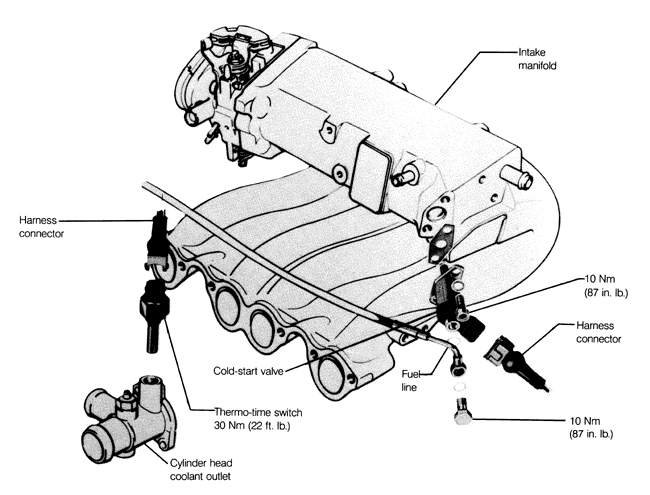5.2 Cold Start Enrichment
The electrically operated cold-start valve sprays extra fuel into the intake manifold for several seconds when the starter is actuated and the engine is cold. The valve is controlled by the thermo-time switch, located in the cylinder head coolant outlet. When the engine is cold, the switch is closed allowing power to reach the valve and open it. When the engine is warm, the switch is open and the valve does not operate. To limit valve operation and prevent flooding, the electric current also warms the switch and opens the circuit after a few seconds. The cold-start valve and the thermo-time switch are shown in Fig. 5-6.
| Fig. 5-6. | Cold-start valve and thermo-time switch used to provide extra fuel for cold starting. |

|
If the cold-start valve fails to inject fuel during cold starting, it will be difficult or impossible to start the engine. If the cold-start valve leaks, the engine may receive extra fuel at the wrong time and become flooded, especially if the engine is hot.
To test cold start valve:
| 1. | Make sure engine coolant temperature is below 86°F (30°C). Preferably the engine should sit for several hours. |
| 2. | Remove the two screws holding the cold start valve to the intake manifold. Without disconnecting the fuel line or the harness connector, remove the cold start valve from the intake manifold. |
| 3. | Disconnect the coil wire from the center tower of the distributor cap and connect it to ground, using a jumper wire if necessary. |
| 4. | Wipe dry the nozzle of the cold start valve. Point the valve into a transparent container, and have a helper actuate the starter. See Fig. 5-7. |
WARNING-
Fuel will be expelled. Do not smoke or work near heaters or other fire hazards. Keep a fire extinguisher handy.
|
| Fig. 5-7. | Cold-start valve operation being checked. |

|
NOTE-
The valve should spray in an even, cone-shaped pattern until the thermo-time switch interrupts the circuit. An irregular spray pattern indicates a dirty or faulty cold start valve. If the valve does not spray, test the thermo-time switch as described below.
|
| 5. | Wipe the nozzle dry. The valve should not drip for at least a minute. If it does, it is faulty and should be replaced. |
To test thermo-time switch:
| 1. | Make sure engine coolant temperature is below 86°F (30°C). Preferably the engine should sit for several hours. |
| 2. | Disconnect the coil wire from the center tower of the distributor cap and connect it to ground, using a jumper wire if necessary. |
| 3. | Disconnect the cold-start valve harness connector and connect a test light across the connector terminals, as shown in Fig. 5-8. |
| Fig. 5-8. | Test light connected across cold-start valve harness connector. Location shown is different than on cars covered by this manual. |

|
| 4. | Actuate the starter while observing the test light. The test light should light for several seconds, then go out. The amount of time that the light should stay on depends on coolant temperature. See the graph in Fig. 5-9. |
| Fig. 5-9. | Graph of thermo-time switch response to coolant temperature. Switch completes circuit to open cold-start valve for number of seconds shown. Example: at coolant temperature of 68°F (20°C), switch is closed for 1 to 3.7 seconds. |

|
NOTE-
If the test light does not light, it is either because voltage is not reaching the connector due to faulty wiring, or because the path to ground (through the thermo-time switch) is interrupted by a faulty switch or wire. Consult the current flow diagrams in ELECTRICAL SYSTEM for help in identifying wires and terminals.
|
To replace the thermo-time switch, first drain the coolant from the engine as described in COOLING SYSTEM. Use a thread sealant and torque the new switch to 30 Nm (22 ft. lb.). Then, refill the cooling system with coolant.
|



